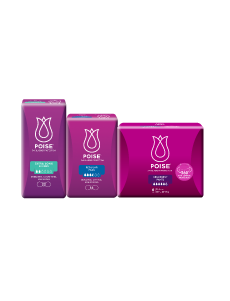What Happens After Pregnancy
Being pregnant is commonly said to be one of the most exciting and celebrated experiences in a woman’s life, but what’s also common during this period is you could begin to experience light bladder leakage or pregnancy incontinence for the very first time. This can even continue once your new bundle of joy has arrived so don’t worry, it's normal. There’s nothing to be ashamed of or embarrassed about, it’s just part of the extra pressures your body experiences during pregnancy.
During pregnancy your body experiences many changes and, as your baby grows, often the pressure on your bladder will increase too. All the extra weight pressing down on your pelvic floor muscles weakens them, which usually means the amount of urine your bladder can typically hold decreases. So, during pregnancy you’ll find yourself having to urinate more frequently, or you may experience loss of bladder control.
After having your baby, the truth is, you might find that your bladder leakage persists.
Why? Well, pushing your baby through the birth canal places will result in all sorts of stretching pressures on most of your pelvic organs. While some women might be able to withstand that kind of pressure more than others, some may find the process has put a huge strain on their bladder, which can again trigger a reduction in bladder control.
While most women will eventually and slowly regain control of their bladder, it’s important to note though that this can commonly be aggravated again further down the track (and by further down the track, we hopefully mean many years), by such natural changes like menopause. Luckily, having your children and seeing them grow up is worth the inconvenience!
Muscles will be regained after some time, so pregnancy incontinence should only last for a short period after giving birth. If you’re still experiencing light bladder leakage more than six weeks after you’ve given birth you should consult your doctor. It’s always recommended that you talk to your doctor or health care professional when it comes to helping you determine, control and improve your loss of bladder control to fit with your own unique lifestyle.
POISE® has a wide product offering of Liners and Pads that are all specially designed to help you manage light bladder leakage 2X better in absorption^ than period products as and when it happens, but all in a discreet manner and by keeping you comfortable.
This content is not intended to be a substitute for professional medical advice, diagnosis or treatment. Always seek advice from a qualified health care professional with any questions regarding your concerns.
Where To Buy
These articles might also be interesting to you
^vs leading FEMCARE brands.
Sources
Arnold, J., McLeod, N., Thani-Gasalam, R. and Rachid, P. (2012). RACGP - Overactive bladder syndrome –management and treatment options. [online] Racgp.org.au. Available at:
http://www.racgp.org.au/afp/2012/november/overactive-bladder-syndrome/
[Accessed 6 Apr. 2015].
Bladderclinic.com.au, (2011). Overactive Bladder (OAB). [online] Available at:
http://www.bladderclinic.com.au/bladder/overactive-bladder-oab [Accessed 6 Apr. 2015].
Cherney, K. (2013). Home Remedies for Overactive Bladder. [online] Healthline. Available at:
http://www.healthline.com/health/overactive-bladder/home-remedies#Overview1
[Accessed 6 Apr. 2015].
Eilber, MD, K. (2015). What Is The Difference Between A Small Bladder And An .... [online] EmpowHER. Available at:
http://www.empowher.com/overactive-bladder/content/what-difference-between-small-bladder-and-overactive-bladder-dr-
[Accessed 6 Apr. 2015]
Maher, MD, C. (2003). Welcome to Chris Maher's Urogynaecology Australia Web Site. [online] Urogynaecology.com.au. Available at:
http://www.urogynaecology.com.au/Overactive.htm [Accessed 6 Apr. 2015].
Siamak N. Nabili, M. (2014). Overactive Bladder: Facts for Men, Women, and Children. [online] MedicineNet. Available at:
http://www.medicinenet.com/overactive_bladder/article.htm [Accessed 6 Apr. 2015].
Tidy, MD, C. (2013). Overactive Bladder Syndrome, Bladder Problems | Health | Patient.co.uk. [online] Patient.co.uk. Available at:
http://www.patient.co.uk/health/overactive-bladder-syndrome [Accessed 6 Apr. 2015].
Webmd.com, (2014). Overactive Bladder in Children (Child Incontinence): Signs, Causes, and Treatment. [online] Available at:
http://www.WebMD.com/urinary-incontinence-oab/overactive-bladder-in-children
[Accessed 6 Apr. 2015].
Canceraustralia.gov.au, (2019). Bladder cancer statistics in Australia | Bladder Cancer. [online] Available at:
https://bladder-cancer.canceraustralia.gov.au/statistics
[Accessed 6 Jun. 2019].
Other urinary incontinence causes









